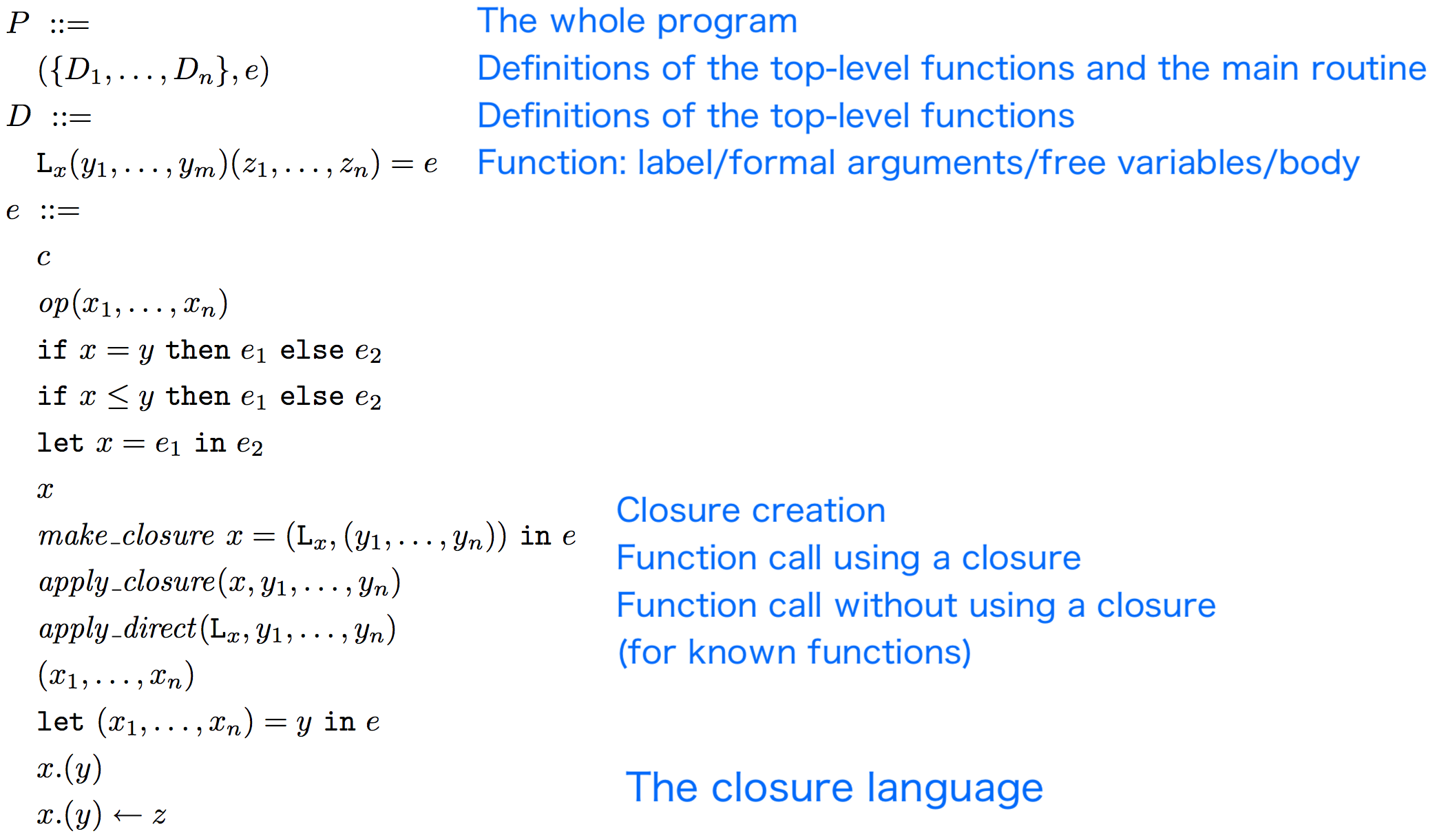Optimization
Ken Wakita (https://wakita.github.io/fp2018/)
Nov. 1, 2018
Overview
Compiler Pipeline
let rec iter n e = (* Iterative optimization *)
if n = 0 then e else
let e' = Elim.f (ConstFold.f (Inline.f (Assoc.f (Beta.f e)))) in
if e = e' then e else
iter (n - 1) e'
let lexbuf outchan l =
...... .......
(..........
(......
(.........
(.........
(iter !limit
(.......
(.........
(........
(.......... ........... .)))))))))Constant Folding
Constant Folding Format
\[\begin {align} {\cal F}&: \text {KNormal.t M.t} \rightarrow \text {KNormal.t} \rightarrow \text {KNormal.t} \\ \varepsilon&: v \mapsto e \\ {\cal F}_\varepsilon(e) &= e' \end {align}\]
Contant Folding Examples
\[\begin {align} {\cal F}_\varepsilon(1 + 2) &\Rightarrow 3 \\ \text {let } x = 5 \text { in } x + x &\Rightarrow 10 \\ {\cal F}_\varepsilon(\text {if } x = y \text { then } e_1 \text { else } e_2) &\Rightarrow {\cal F}_\varepsilon(e_1) \quad \varepsilon(x) \equiv \varepsilon(y) \\ \end {align}\]
Simple CF
# constfold constfold_p;;
Let (Ti3.4,
Let (x.5, 1, Let (y.6, 2,
Let (Ti2.7, Let (Ti1.8, 1, 1),
IfEq (Ti2.7, x.5, 3, 2)))), ...)Constant folding has reduced x + y to 3 and y to 2 but there seems to be room for more optimization.
Let-Assoc + CF
What if combined with let-associativity reduction?
# ConstFold.f (assoc constfold_p);;
Let (x.13, 1,
Let (y.14, 2,
Let (Ti9.16, 1,
Let (Ti10.15, 1,
Let (Ti11.12, 3, ...)))))Now the if expression and the else clause of the if expression has disappeared.
The Essense of Constant Folding
\[\begin {align} {\cal F}_\varepsilon(\text {let } x = e_1 \text { in } e_2) &= \text {let } x = {\cal F}_\varepsilon(e_1) \text { in } {\cal F}_{\varepsilon'}(e_2) \\ & \text {where } \varepsilon' = {\varepsilon, x \mapsto {\cal F}_\varepsilon(e_1)} \\ & \\ {\cal F}_\varepsilon(\mathit {op}(x_1,\ldots,x_n)) &= c \quad \text {if } \mathit {op}(\varepsilon(x_1), \ldots, \varepsilon(x_n)) = c \end {align}\]
Implementation of Constant Folding
let findi x env = (match M.find x env with Int(i) -> i | _ -> raise Not_found)
...
let rec g env = function (* The body of the constant folding routine *)
| ...
| Neg(x) when memi x env -> Int(-(findi x env))
| ...
| Let((x, t), e1, e2) -> (* Case "let" *)
let e1' = g env e1 in
let e2' = g (M.add x e1' env) e2 in
Let((x, t), e1', e2')
| ...Elimination of Redundant Definitions
RDE Format
Elimination
\[\begin {align} \varepsilon &: \text {KNormal.t} \rightarrow \text {KNormal.t} \\ \varepsilon(e) &= e' \\ \end {align}\]
Effect System (Detection of side effects)
\[\begin {align} \mathit {effect} &: \text {KNormal.t} \rightarrow \text {bool} \\ \mathit {effect}(e) &= \text {true/false} \\ \mathit {effect}(1) &= \text {false} \\ \mathit {effect}(\text {println(1)}) &= \text {true} \\ \mathit {effect}(\text {array.(0) <- 0}) &= \text {true} \qquad \text {# Array assignment} \end {align}\]
RDE Examples (Unused Variables)
\[\begin {align} \varepsilon(\text {let x = 1 in 0}) &\Rightarrow 0 \\ \varepsilon(\text {let x = 1 in x + 1}) &\Rightarrow \text {let x = 1 in x + 1} \end {align}\]
RDE Example (Unused Functions)
\[\begin {align} \varepsilon(\text {let rec f x = 1 in 0}) &\Rightarrow 0 \\ \varepsilon(\text {let rec f x = x + 1 in f 0}) &\Rightarrow \text {let f x = x + 1 in f 0} \end {align}\]
RDE Examples (Effects of Effects)
\[\begin {align} \varepsilon(\text {let } x = f() \text { in } 0) &= \ ??? \\ \\ ^*\text {case 1} &: \text {f() = 1} \quad\text {// effect free} \\ ^*\text {case 2} &: \text {f() = y} \quad\text {// effect free} \\ \text {case 3} &: \text {f() = array.(0) <- 0} \quad\text {// Assignment}\\ \text {case 4} &: \text {f() = println("Effect!")} \quad\text {// Input-Output}\\ \end {align}\]
A Question
Why the let rec rule in RDE definition says
\[ \mathit {effect}(\text {let rec } x\ y_1\ \ldots\ y_n = e_1 \text { in } e_2) = \mathit {effect}(e_2) \]
but not
\[ \mathit {effect}(\text {let rec } x\ y_1\ \ldots\ y_n = e_1 \text { in } e_2) = \mathit {effect}(e_1) \vee \mathit {effect}(e_2) \]
Implementation of Side Effect Analysis
let rec effect = function (* detection of side effects *)
| Let(_, e1, e2) -> effect e1 || effect e2
| LetRec(_, e)
| LetTuple(_, _, e) -> effect e
| IfEq(_, _, e1, e2) | IfLE(_, _, e1, e2) -> effect e1 || effect e2
| App _ | ExtFunApp _
| Put _ -> true
| _ -> falseNaming constructs (
Let*) have no side effectsConditionals’ side effects depends on those of their subcomponents
- Function applications may have side effects (conservative decision)
ExtFunApp: external function application, also
Assignments have side effects
Others are free of side effects
Implementation of Redundancy Elimination
For let:
\[\begin {align} \varepsilon(\text {let } &x = e_1 \text { in } e_2) = \\ & \begin {cases} \varepsilon(e_2) & \neg \mathit {effect}(\varepsilon(e_1)) \wedge\\ & x \not\in \mathit {free\_variables}(\varepsilon(e_2)) \\ \text {let } x = \varepsilon(e_1) \text { in } \varepsilon(e_2) & \text {Otherwise} \end {cases} \end {align}\]
Implementation of Redundancy Elimination
For let rec:
\[\begin {align} \varepsilon(&\text {let rec } x\ y_1\ \ldots\ y_n = e_1 \text { in } e_2) = \\ & \begin {cases} \varepsilon(e_2) & \text {When } x \not\in \mathit {free\_variables}(\varepsilon(e_2)) \\ \text {let rec } x\ y_1\ \ldots\ y_n = \varepsilon(e_1) \text { in } \varepsilon(e_2) \\ & \text {Otherwise} \end {cases} \end {align}\]
Closure Language
Closure Language

Closure Language vs K-Normal Form
What’s gone
let rec: locally-defined functions
What’s new
Top-level function declarations:
\(D = \{ L_{\text {fib}}(n)() = \text {if n <= 1 then 1 else fib (n - 1) + fib (n - 2)} \}\)
make_closure
What’s different
- Function application \(\rightarrow\) apply_closure and apply_direct